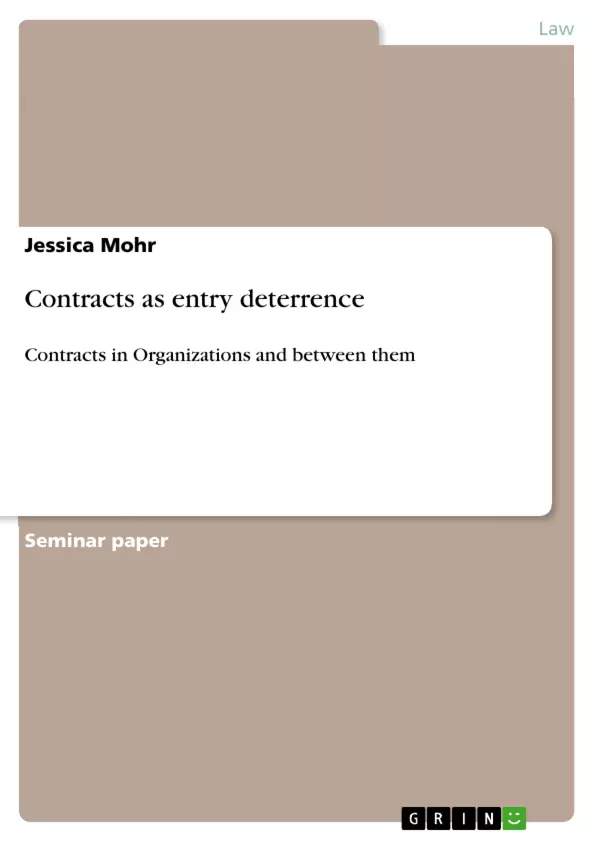Contracts between buyers and sellers can have social welfare decreasing effects. They prevent entry of entrants with lower production costs than the incumbent, even though they not always prevent it entirely. The buyers may be better of accepting a contract, when the price and liquidated damages specified in it generate higher surplus for the buyer than without a contract. However, the contracts are disadvantageous for other society members. Free-rider problems occur, too. New financial means (options) may diminish the negative effects of contracts. In considering contracts’ implications entirely, also their duration is important.
Inhaltsverzeichnis (Table of Contents)
- The basics
- Optimal Contracts between One Buyer and an Incumbent Seller
- The theoretical approach
- Asymmetric information about the probability of entry
Zielsetzung und Themenschwerpunkte (Objectives and Key Themes)
This paper explores the relationship between contracts between buyers and sellers and the deterrence of entry in a market. The main goal is to analyze whether these contracts can hinder the entrance of new competitors with lower production costs than the existing seller. The paper examines the impact of these contracts on social welfare, analyzing potential negative effects and considering the role of liquidated damages.
- The impact of contracts between buyers and sellers on entry deterrence
- The social welfare implications of exclusive contracts
- The role of liquidated damages in preventing entry and their effect on the buyer's and incumbent's payoffs
- The significance of contract duration in influencing entry deterrence
- The effects of asymmetric information about the probability of entry on optimal contract design
Zusammenfassung der Kapitel (Chapter Summaries)
- The basics: This section introduces the central argument of the paper by examining the potential entry deterrence effects of contracts between buyers and sellers. It highlights the potential negative welfare implications of such contracts and introduces the concept of liquidated damages as a deterrent to new entrants.
- Optimal Contracts between One Buyer and an Incumbent Seller: This chapter presents a theoretical model illustrating the relationship between a buyer and an incumbent seller. The model demonstrates how contracts can act as a barrier to entry by creating a coalition between the buyer and seller, essentially forming a non-discriminating monopolist against potential competitors.
- The theoretical approach: This section delves into the specific details of the theoretical model used to analyze the dynamics of the contract between a buyer and an incumbent seller. It explores the role of the buyer's reservation price, the entrant's unknown production costs, and the probability of entry in shaping the dynamics of the market. The model highlights the limitations of simple contracts and the potential for social costs to arise from their implementation.
- Asymmetric information about the probability of entry: This section examines the complexities introduced by asymmetric information about the probability of entry, considering the case where the incumbent has private knowledge about the likelihood of new entrants entering the market. It explores the limitations of simple contracts and the need for more sophisticated contract structures to address the issue of information asymmetry. The section investigates how contract duration and liquidated damages can be used as signals for the probability of entry, and how these strategies can be used by the incumbent to influence the buyer's beliefs and ultimately achieve a more favorable outcome.
Schlüsselwörter (Keywords)
The core keywords of this paper are contracts, entry deterrence, social welfare, liquidated damages, contract duration, asymmetric information, and monopolist. The paper explores how these concepts interact to shape the dynamics of markets, with a focus on understanding the implications of contracts for both economic efficiency and market competition.
- Quote paper
- Jessica Mohr (Author), 2009, Contracts as entry deterrence, Munich, GRIN Verlag, https://www.grin.com/document/127109



